Fritillaria imperialis: planting, care & the most beautiful varieties
Fritillaria imperialis or crown imperial is one of the oldest cultivated garden plants and thus, in a sense, a must-have in any classic cottage garden.

In the Orient, crown imperial (Fritillaria imperialis) has been planted since time immemorial. If you place the royal plant in the appropriate location, even novice gardeners will succeed with it for several years. Here, we show you what you need to consider when planting and the beautiful varieties the crown imperial has to offer.
Contents
Crown imperial: origin and properties
The crown imperial belongs to the lily family (Liliaceae) and owes its name to the large flowers that hang like crowns. Also, the species name imperialis means imperial. Fritillaria imperialis is naturally distributed from Asia Minor and the Middle East to the Himalayas. It is said that the crown imperial refused to bow its head when Christ was crucified. Later, however, it let its flowers droop and has been crying ever since. Therefore, the Persian name for the historical plant is “Ashk-e-Maryam” – Tears of Mary. In our country, the crown imperial is also known as royal crown, royal lily or crown flower and has been used as an ornamental plant since the Middle Ages.
The perennial crown imperial is a bulbous plant and sprouts from March. The unbranched stem has lanceolate leaves on the lower half and develops four to eight flowers at its tip, depending on the variety. These are crowned by a head of leaves. In total, the crown imperial grows up to 140 cm in height. The orange flowers have a distinctive scent, which many people find unpleasant. The bulb itself is also intensely fragrant, which is why some gardeners suggest that the crown imperial can deter voles. However, there is no evidence for this. Besides the orange-flowered Fritillaria imperialis, a white-flowered form existed until the 18th century, which has since disappeared.

After flowering, the foliage retracts relatively quickly and is usually considered unattractive, which is why it is worth combining crown imperial with late-sprouting grasses. These can cover leftover foliage if well placed.
When does crown imperial bloom? Crown imperial blooms between March and May, although it can be earlier or later in this period depending on the variety. Crown imperial is bee friendly, with only moderate nectar and pollen available to bees and bumblebees.
The most beautiful species and varieties
Although Fritillaria imperialis in itself is a distinctive feature in the garden, it is still worth considering different varieties. We have put together the most beautiful one’s for you.
- ‘Lutea Maxima’ grows up to 100 cm tall and blooms a brilliant yellow. The smell of this variety is very intense.
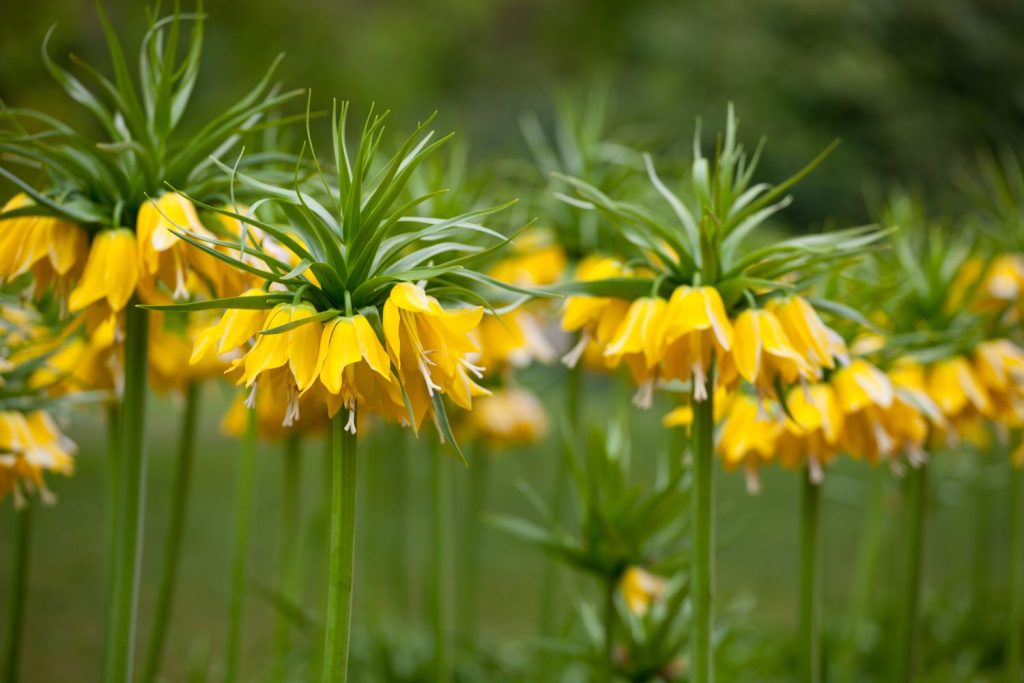
- ‘Prolifera’ has two orange-red flower spikes and has been used in gardens since the 16th century.
- ‘Rubra Maxima’ flowers equally orange-red and reaches a height of 100 cm. This variety is somewhat more sensitive to late frost than its relatives.

- ‘Argenteovariegata’ draws the eye with its white-edged leaves. The flowers appear a red colour. This variety grows up to 70 cm tall.
- ‘Garland Star’ grows up to 120 cm tall and impresses with its brown-black flower stems. The orange flowers create a beautiful contrast here.
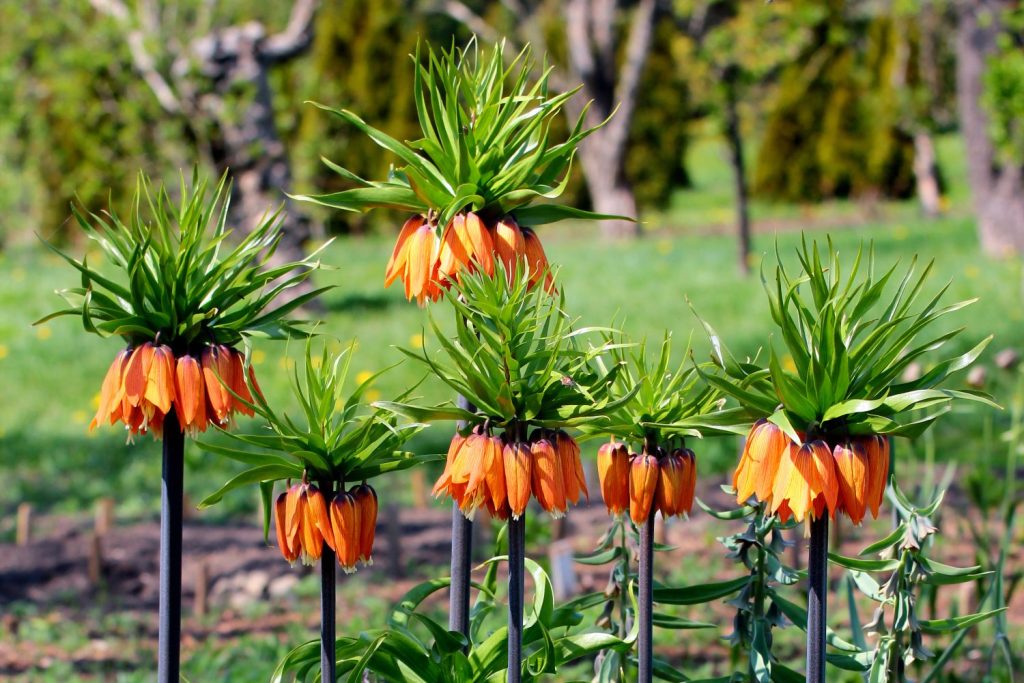
The Fritillaria genus has other beautiful species to offer our gardens in addition to Fritillaria imperialis:
- The dwarf crown imperial (Fritillaria raddeana) reaches a growth height of around 80 cm. The new shoots are usually red in colour while the flowers are a delicate yellow. This species is somewhat sensitive to frost and so requires a location protected from wind and moisture.

- The checkered lily (Fritillaria meleagris) grows no taller than 30 cm and produces bell-shaped, drooping flowers. These are purple-white and therefore resemble a chessboard. It is native to our country and is under protection.
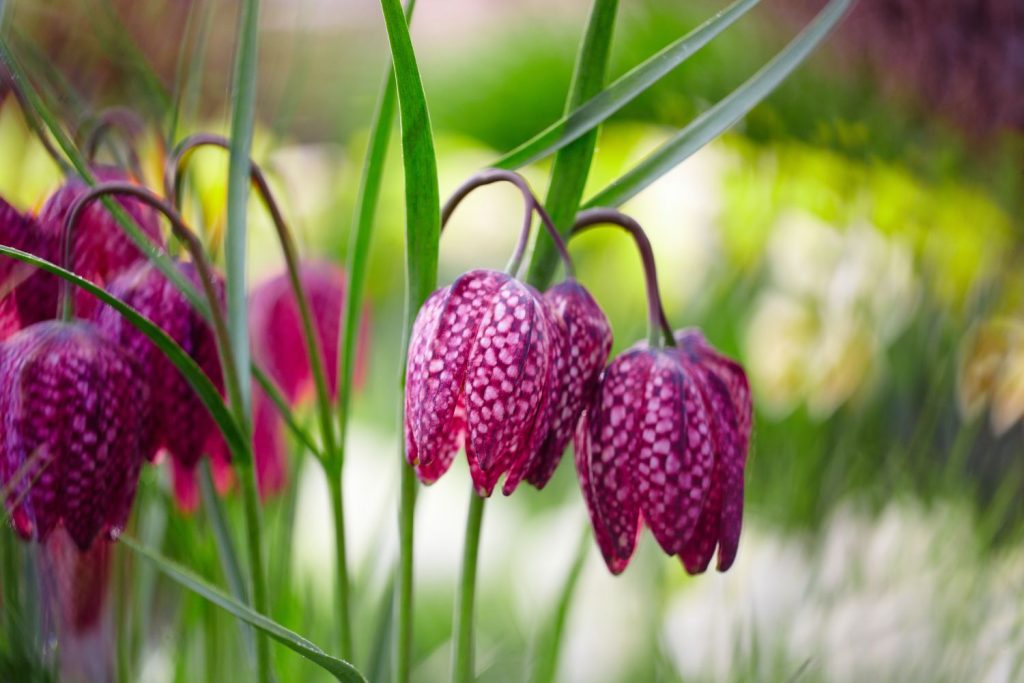
- A Persian crown imperial (Fritillaria persica) displays several flowers without a leaf head at the end of the flower stalk. This species is sensitive to frost and should be dug up and overwintered before winter. It reaches a total height of 80 cm. The flowers appear in a purple-brown hue.
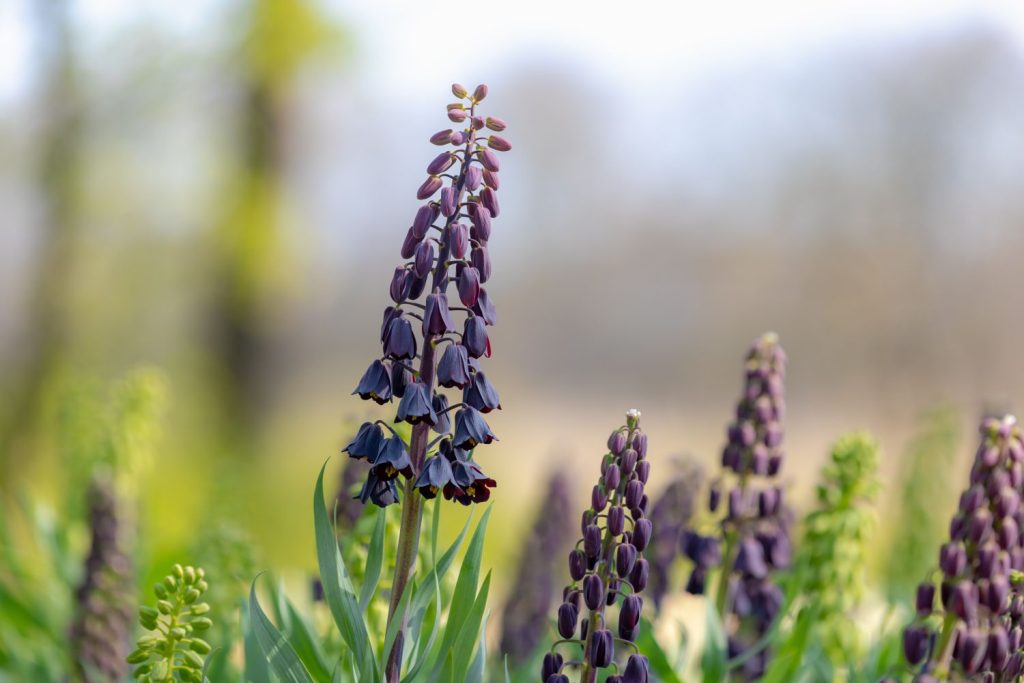
Planting crown imperial: location and method
The crown imperial prefers a sunny to off-sun location. For darker varieties, blazing midday sun may cause the flowers to fade but does not harm the plant per se. Unfortunately, strong competitors such as dominant trees soon displace the crown imperial – in a bed, however, you can plant it far enough from other large perennials or bulbous plants. The soil should be well-drained, nutritious and fresh, especially in the spring. Extremely sandy or heavy clay soils also cause hesitant, less splendid development and the bulbous plant will soon disappear.
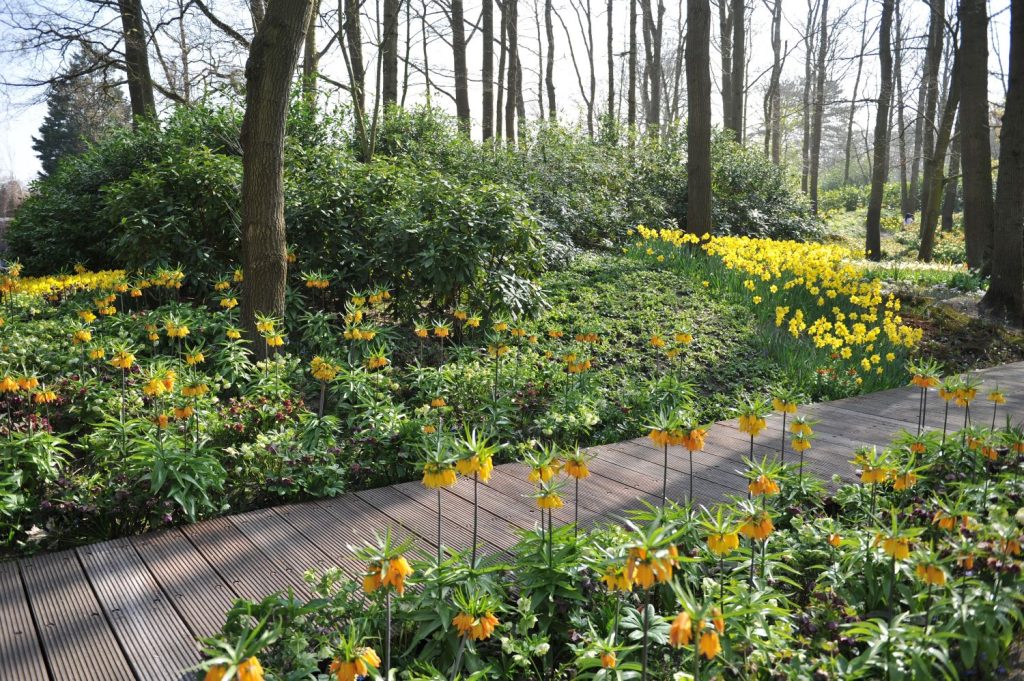
Tip: like many bulbous plants, the crown imperial does not tolerate waterlogging. Therefore, place a drainage layer of gravel or chippings before you plant the bulbs.
To give the bulb enough time to take root, the optimal time for planting is in late summer to early autumn. Insert the bulb 20-25 cm deep and observe a planting distance of at least 40 cm. The hole of the bulb should face up. Crown imperials are best in small groups of 3 to 10 plants together. Combining them with other flowering plants is usually not recommended, otherwise the overall effect will look overloaded. Instead, combine the crown imperial with plain boxwood (Buxus spec.) or ornamental grasses – or simply leave it by itself.
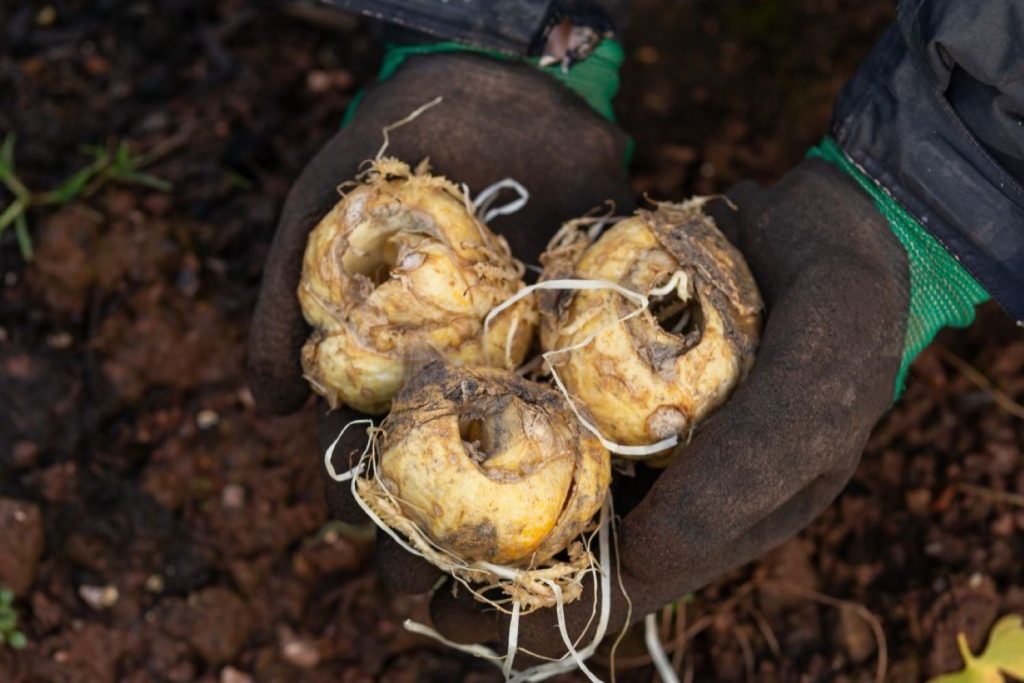
The crown imperial can also be cultivated well in a container. Choose a planter that gives the plant about 20 cm of space to the edge of the pot. Likewise, make sure that the water drainage hole is large. Place a drainage layer at the bottom, for example, expanded clay. We recommend high-quality potting soil as a substrate. Our Plantura Organic Flower Compost contains compost and primarily organic fertiliser with expanded clay, which ensures optimal permeability of the substrate and less total weight. However, it is worth mixing in additional expanded clay for the culture of the crown imperial. In addition, the soil is 100% peat-free and therefore produced more environmentally friendly than other substrates.
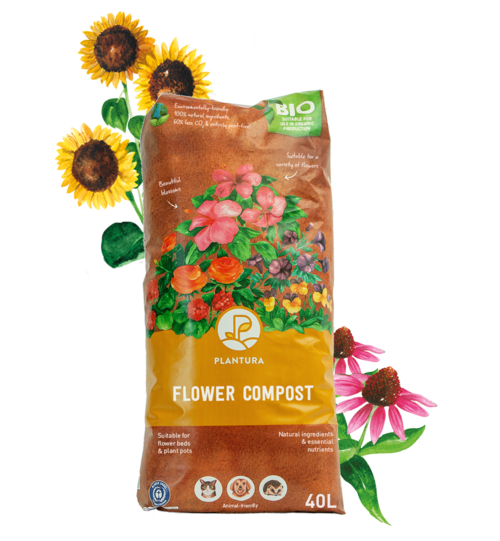
- Perfect for all flowering plants in garden beds & pots
- For beautiful blossoms & healthy plant growth
- Peat-free & organic soil: CO2-saving composition
The right care
If you provide the crown imperial with a suitable location, it does not require further care. It is often recommended to transplant the bulb every four to five years. If the crown imperial is supplied with sufficient nutrients, it can remain in the same location without any problems. If the Fritillaria ever needs to change location, this should happen during the dormant season when it is not bearing foliage.
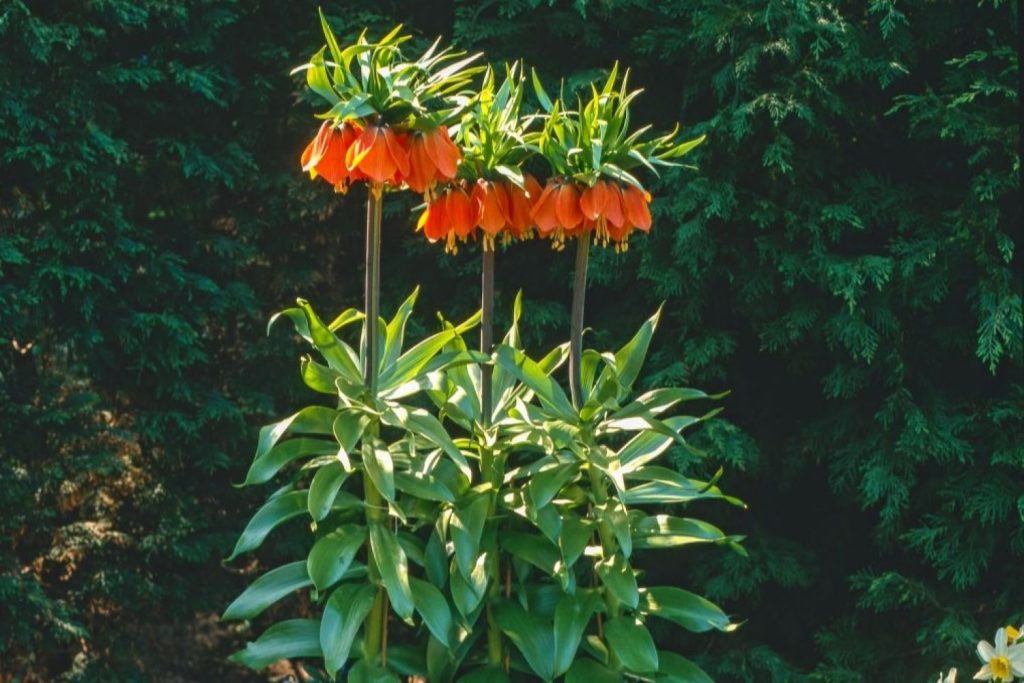
Crown imperials have relatively high nitrogen requirements compared to other bulb geophytes. Therefore, they should be fertilised annually in the spring. For example, our Plantura Liquid Flower Food has a nitrogen-rich nutrient ratio. This is enough to support the crown imperial for a whole season. If the bulb is planted in fresh potting soil that is well supplied with nutrients, fertiliser can be omitted in the first spring.

- Perfect for all flowers & balcony plants
- Liquid fertiliser for a lush blossom throughout the season
- Quick & easy application - child & pet friendly
Tip: in spring, make sure the crown imperial is not too dry and water the young plant if necessary – drought stress is not tolerated well during budding.
Pruning should be done only in the summer when the foliage has completely yellowed. The bulb absorbs nutrients from the foliage, which are necessary for overwintering. If the foliage is pruned too early, new shoots may not appear in the spring.

Is crown imperial hardy?
Yes, the crown imperial is hardy and tolerates temperatures down to -34 ° C. If the crown imperial does not sprout in the new year, it may be due to the location – impermeable soils cause winter waterlogging and thus rotting of the bulb. Frost is an even bigger problem for plants in pots or tubs. Therefore, place the pot in a sheltered place and wrap the planter with fleece or a jute bag. Watering should be very seldom – the substrate is best kept rather dry in the winter.
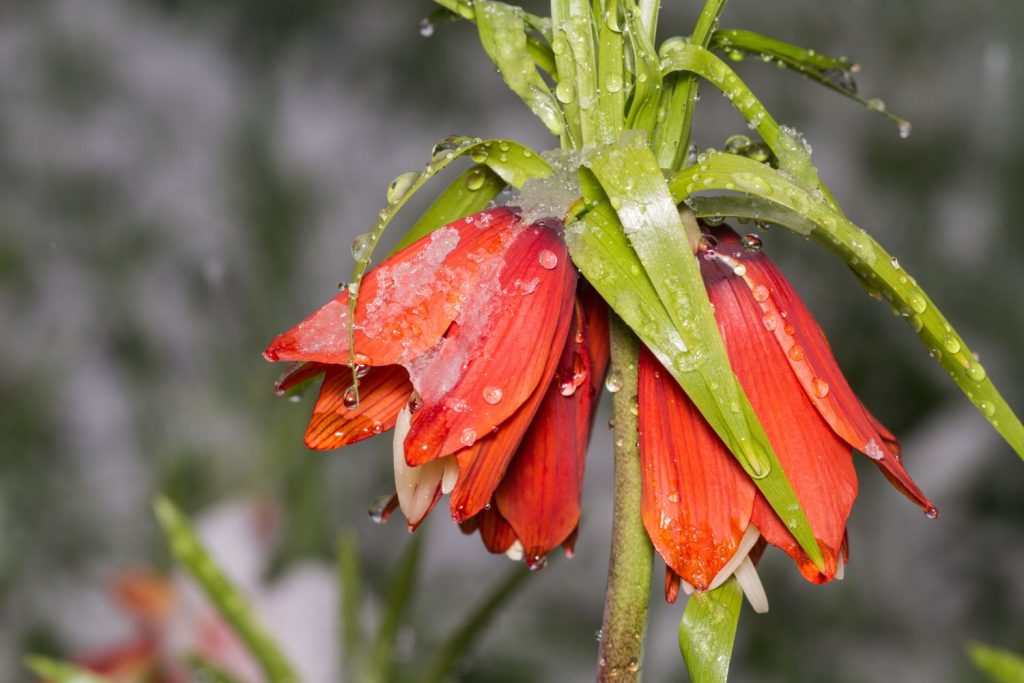
Propagating crown imperial
The most promising and fastest way to propagate the crown imperial is through daughter bulbs. However, this variant only works for older, more established specimens. To do this, dig up the bulb in late summer once the foliage has turned yellow. Remove the daughter bulb, which can be seen on the outside. The mother and daughter bulbs can be replanted directly a sufficient distance apart.
Propagating the crown imperial by seed, on the other hand, is somewhat more laborious: most varieties only seed in the case of cross-pollination, that is, with the help of other varieties. Good fertilisation occurs when at least two different varieties are next to each other and bloom almost simultaneously. The seeds fully mature and can be harvested in late summer. At best, allow the seeds to soak in water for 24 hours before spreading them on substrate or soil and pressing down only lightly. Since it is a so-called cold germinator, the seed needs the winter cold stimulus to germinate in the spring. Crown imperial seeds emerge unevenly, so some seeds may take significantly longer than others.
Note: it may take several years for seed-propagated crown imperials to flower. However, you may find the appearance of this self-combined plant surprising.

Is crown imperial poisonous?
Yes, crown imperial is poisonous to humans and animals. It contains the toxins imperialin and fritillin in all parts of the plant, but especially in its bulb. When consumed, symptoms of poisoning such as nausea and vomiting may occur. Heart and circulatory problems are also possible. Severe poisoning can even lead to cardiac arrest.
The glory crown (Gloriosa superba) is also poisonous and given an imposing name. It is used in our country as a container or houseplant and is suitable as a beautiful cut flower.



















